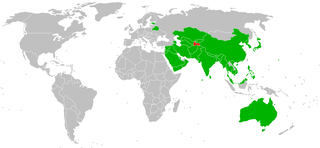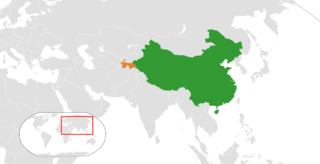
Central Asia stretches from the Caspian Sea in the west to China in the east and from Afghanistan in the south to Russia in the north. The region consists of the former Soviet republics of Kazakhstan, Kyrgyzstan, Tajikistan, Turkmenistan, and Uzbekistan. It is also colloquially referred to as "the stans" as the countries generally considered to be within the region all have names ending with the Persian suffix "-stan", meaning "land of".

Since independence, Tajikistan gradually followed the path of transition economy, reforming its economic policies. With foreign revenue precariously dependent upon exports of cotton and aluminium, the economy is highly vulnerable to external shocks. Tajikistan's economy also incorporates a massive black market, primarily focused on the drug trade with Afghanistan, and heroin trafficking in Tajikistan is estimated to be equivalent 30-50% of national GDP as of 2012. In fiscal year (FY) 2000, international assistance remained an essential source of support for rehabilitation programs that reintegrated former civil war combatants into the civilian economy, thus helping keep the peace. International assistance also was necessary to address the second year of severe drought that resulted in a continued shortfall of food production. Tajikistan's economy grew substantially after the war. The gross domestic product (GDP) of Tajikistan expanded at an average rate of 9.6% over the period of 2000-2007 according to the World Bank data. This improved Tajikistan's position among other Central Asian countries, which have degraded economically ever since. As of August 2009, an estimated 60% of Tajikistani citizens live below the poverty line. The 2008 global financial crisis has hit Tajikistan hard, both domestically and internationally. Tajikistan has been hit harder than many countries because it already has a high poverty rate and because many of its citizens depend on remittances from expatriate Tajikistanis.

Foreign relations of Tajikistan are based on a desire to secure foreign investment and promote regional security while ensuring Tajikistan's independence. Sirodjidin Aslov is the current Foreign Minister of Tajikistan.
Tajiks are a Persian-speaking Iranian ethnic group native to Afghanistan, Tajikistan, and Uzbekistan. Tajiks are the largest ethnicity in Tajikistan, and the second largest in Afghanistan which constitutes over half of the global Tajik population. They speak varieties of Persian, a Western Iranian language. In Tajikistan, since the 1939 Soviet census, its small Pamiri and Yaghnobi ethnic groups are included as Tajiks. In China, the term is used to refer to its Pamiri ethnic groups, the Tajiks of Xinjiang, who speak the Eastern Iranian Pamiri languages. In Afghanistan, the Pamiris are counted as a separate ethnic group.

The President of Tajikistan is the head of state and the highest position within the Government of Tajikistan. The position of President was created in November 1990 while Tajikistan was still a Soviet Republic. The President of Tajikistan lives in the capital, Dushanbe.

Khujand, sometimes spelled Khodjent and known as Leninabad in 1936–1991, is the second-largest city of Tajikistan and the capital of the northernmost province of Tajikistan, now called Sughd. Khujand is one of the oldest cities in Central Asia, dating back about 2,500 years. It is situated on the Syr Darya at the mouth of the Fergana Valley and was a major city along the ancient Silk Road, mainly inhabited by ethnic Tajiks. It is proximate to both the Uzbekistan and Kyrgyzstan borders.

The Tajikistan national football team is a football (soccer) team that represents Tajikistan in association football, and is controlled by the Tajikistan Football Federation, the governing body for football in Tajikistan. Tajikistan's home ground is the Pamir Stadium in Dushanbe.

The Tajikistani Civil War, also known as the Tajik Civil War or the War in Tajikistan, began in May 1992 when regional groups from the Garm and Gorno-Badakhshan regions of Tajikistan rose up against the newly-formed government of President Rahmon Nabiyev, which was dominated by people from the Khujand and Kulyab regions. The rebel groups were led by a combination of liberal democratic reformers and Islamists, who would later organize under the banner of the United Tajik Opposition. The government was supported by Russian border guards.

Dushanbe International Airport is an airport in Dushanbe, the capital of Tajikistan. It is the a main hub for Somon Air and was the home base for now defunct Tajik Air, which also had its head office on the property.

Tajikistan first participated at the Olympic Games as an independent nation in 1996, and has sent athletes to compete in every Summer Olympic Games since then. The nation has also competed at the Winter Olympics since 2002. To date, Andrei Drygin is the only person ever to have represented Tajikistan at the Winter Olympic Games, being his country's sole competitor in 2002, 2006, and 2010.

Tajikistan – United States relations are bilateral relations between Tajikistan and the United States that began in 1992.

United Nations Security Council resolution 1206, adopted unanimously on 12 November 1998, after recalling all resolutions on the situation in Tajikistan and along the Tajik-Afghan border, the Council extended the mandate of the United Nations Mission of Observers in Tajikistan (UNMOT) for a further six months until 15 May 1999.

Tajik passports are issued to citizens of the Republic of Tajikistan to enable them to travel outside the country. It is the international proof of identity of any Tajik citizen.

This page shows the Tajikistan national football team's results in International Matches, as recognized by FIFA:

Visitors to Tajikistan must obtain a visa from one of the Tajikistan diplomatic missions unless they come from one of the visa exempt countries or countries whose citizens are eligible for an electronic visa or a visa on arrival.

China–Tajikistan relations are the bilateral relations between the People's Republic of China and the Republic of Tajikistan, established on January 4, 1992, shortly after the dissolution of the Soviet Union.

The Tajikistan national cricket team represents the nation of Tajikistan in International Cricket competitions and administered by Tajikistan Cricket Federation. Tajikistan has been a member of Asian Cricket Council since 2012. They are an affiliate member of ICC.
















